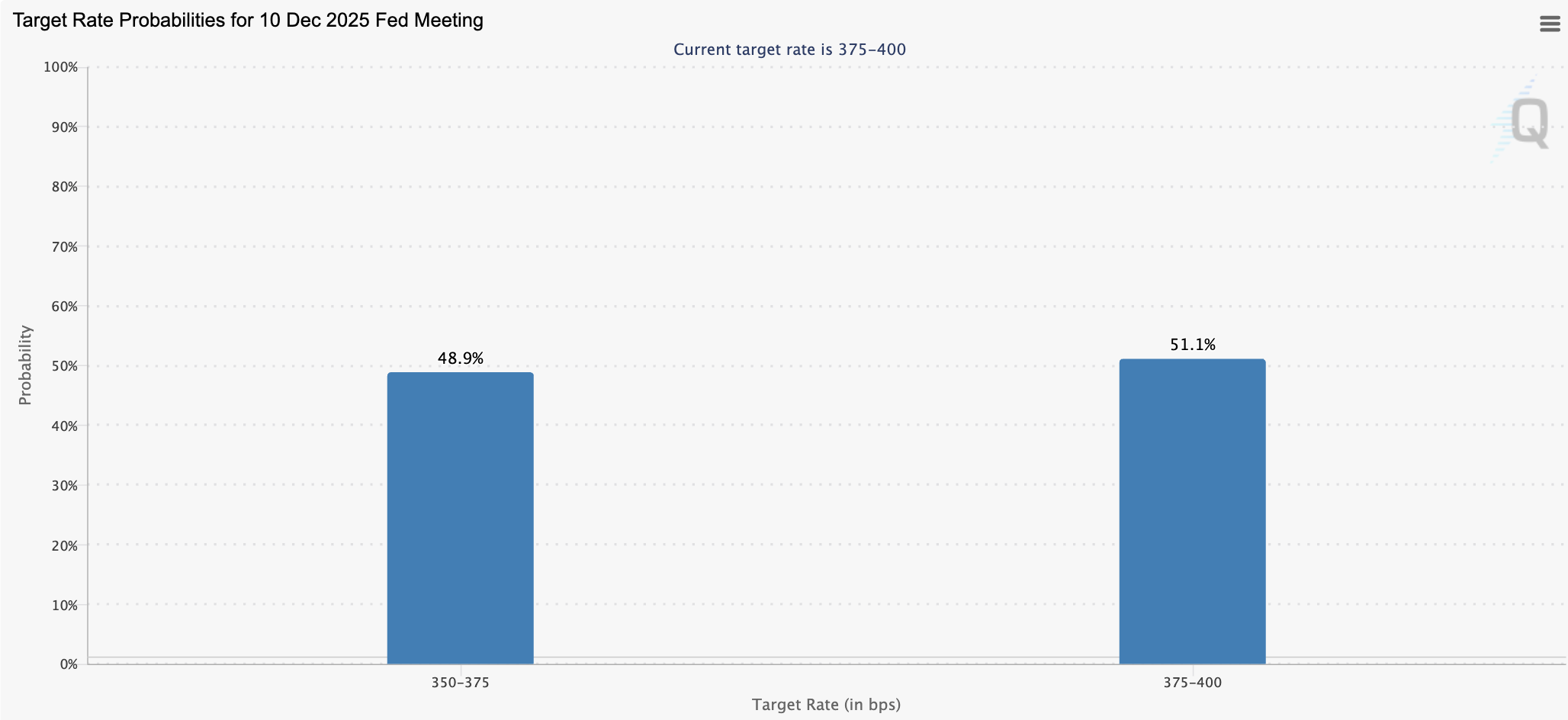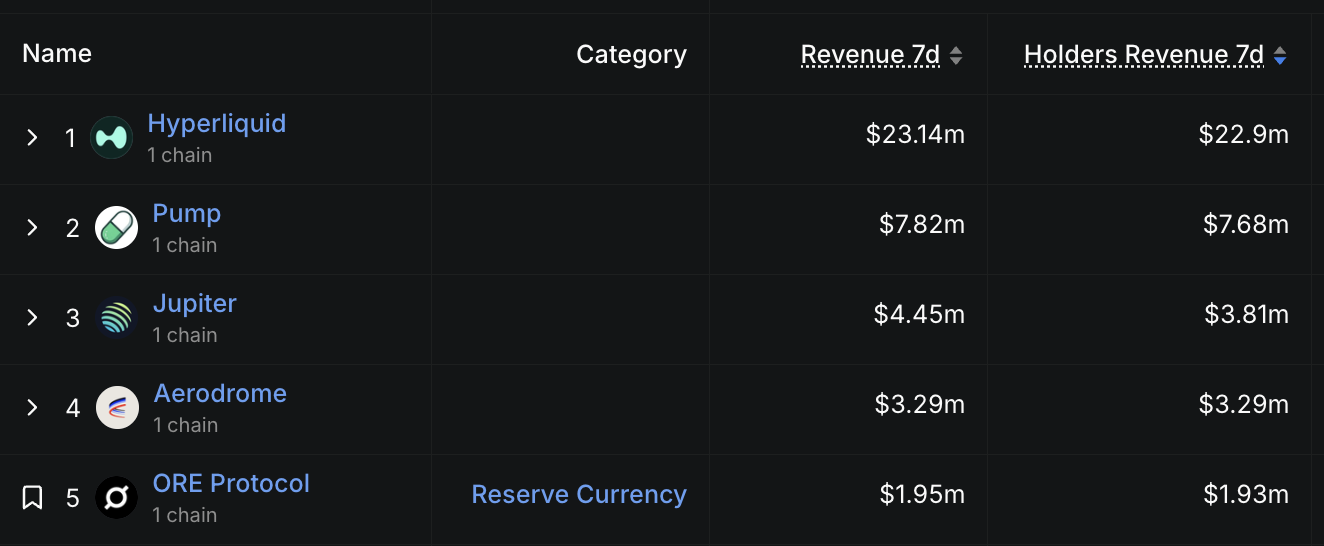Fear Driven Market
Crypto markets have entered a phase of extreme fear, with the Fear and Greed Index hitting 9, its lowest level since April’s bottom. Bitcoin briefly dipped below $90K and closed the weekly candle under its 50-week moving average, the first such close since the previous bear market, while Ethereum also slid temporarily beneath $3K. Today, markets are showing a much needed rebound, with Bitcoin trading near $92K and Ethereum at $3K as we head into what’s likely to be a volatile end of month period.
Interestingly, Bitcoin dominance (BTC.D) has fallen 1.5% this week, suggesting altcoins have held up comparatively stronger on average despite the widespread correction. Two standouts in the sea of red have been HYPE and ASTER, whose strong tokenomics and revenue model have helped support relative performance during heightened volatility, a topic we’ll explore further later in this newsletter.
Why Bitcoin Is Selling Off: The Macro Shift Behind the Move
According to the CMEGroup FedWatch, the odds of a rate cut in December has reduced to under 50% from being over 90% over a month ago. The reduction in rate cut odds stems from persistent inflation, hawkish signals from Fed officials, and economic data delayed by the recent government shutdown. All of these factors have contributed to greater uncertainty and cautious sentiment among institutional investors. As the consensus for imminent monetary easing evaporates, capital has rotated out of riskier digital assets and into safer or yield-bearing alternatives, highlighting crypto’s sensitivity to shifts in macro policy.
On-chain data indicates that long-term Bitcoin holders have gradually been offloading positions. This may be influenced by the disappointment and loss of confidence as a strong seasonal rally in October and November failed to materialise with Bitcoin, with the price roughly unchanged compared to this last year as a result of a massive drawback after an uptrend throughout the period. Meanwhile, institutional investors are demonstrating strong buying interest, absorbing much of the selling pressure. This dynamic points to a structural shift in Bitcoin’s ownership base where early adopters are realising gains while institutions are accumulating.

XRP and SOL Take Their Seat at the Institutional Table
Institutional interest in XRP is gaining traction, underscored by the arrival of new investment vehicles such as Franklin Templeton’s spot XRP ETF and Amplify ETFs’ option-income fund. These products broaden access for traditional investors and reflect a growing acceptance of XRP within established financial circles. Even so, momentum in the market remains uneven. Regulatory clarity is improving and structural barriers are easing, but meaningful capital flows and deep investor conviction have yet to emerge following a massive pullback in the crypto market. The expanding ETF landscape bolsters the long-term case for XRP’s institutional adoption, yet turning that promise into tangible results will depend heavily on near-term execution and broader market sentiment.
VanEck and Fidelity have launched the first U.S. spot Solana (SOL) ETFs. VanEck’s VSOL launched on November 17, 2025, offering direct SOL exposure and staking rewards with fees waived on the first US$1 billion in assets or until February 2026. Fidelity’s FSOL followed on November 18, with fee waivers at launch until; May 2026 before transitioning to a 0.25% expense ratio and 0.15% staking fees. The two funds mark a milestone in Solana’s institutional adoption, positioning it alongside Bitcoin and Ethereum as a core crypto asset class. Both ETFs integrate staking yield as part of investor returns, a first for major altcoin ETFs, and signal growing regulatory acceptance of diversified crypto exposure within traditional investment structures.
Following the ending of the Government Shutdown this week, regulatory agencies such the SEC have resumed functions, which can start to speed up the substantial backlog of crypto ETF applications to move forward. This reopening has already led to expedited approvals for crypto ETFs such as Solana and XRP, with 10+ more waiting to be approved, indicating that regulatory momentum may continue in the coming months.

Harvard Joins MicroStrategy and El Salvador in Buying the Dip
Harvard University has disclosed a stake of roughly US $433 million in Blackrock’s Bitcoin ETF IBIT, representing roughly 1% of Harvard’s total endowment. Despite the broader crypto market facing a sharp downturn, with the US spot Bitcoin ETF seeing over $1 billion in net outflows this week and the Bitcoin Fear and Greed Index signaling “extreme fear”, Harvard University has taken this chance to increase their exposure to Bitcoin.
Bitcoin biggest treasury company MicroStrategy has been under scrutiny as its market capitalisation falls below the value of its Bitcoin holdings following Bitcoin price falling to 90k. This risk is further amplified with MicroStrategy’s Bitcoin purchase being financed through debt, and other instruments. Despite this fearful period, MicroStrategy has acquired 8,178 Bitcoin for $835.6 million this week, boosting the total holdings to 649,870 tokens. While in a bullish period, MicroStrategy could perform exponentially, the highly Bitcoin leverage business model still raises substantial risks during Bitcoin’s drawdowns.
Similarly, in the times of “extreme fear” and significant market selloff, the country El Salvador has increased its bitcoin holdings by 1,090 BTC, with the country’s total bitcoin holdings now approaching 7,500 tokens, continuing with its purchase of 1 BTC per day.
2025 has marked a major milestone for institutional adoption with countries, Wall Street, Silicon Valley and major companies all acknowledging and accumulating crypto rather than characterising it as a speculative asset that it once was.

HYPE and ASTER Lead the Market With Revenue-Driven Strength
Two of the strongest performers this week came from the perpetual DEX / revenue-generating protocol narrative, with HYPE and ASTER both significantly outperforming the market. Their resilience stems from a simple but powerful mechanic, real protocol revenue being automatically converted into buy pressure. HYPE directs 97% of all revenue to buybacks, while ASTER channels 70–80% of its revenue. When volatility spikes, especially during liquidation heavy periods, trading volumes surge, revenues climb, and buybacks accelerate, creating constant demand even as the broader market sells off.

While Bitcoin fell roughly 10%, HYPE stayed green, and ASTER rallied more than 20% across the weekend. This model allows HYPE to accumulate even more tokens at lower prices, strengthening long-term supply dynamics. ASTER has shown the same behaviour, recently averaging over $3M/day in buybacks, reinforcing how effective this design becomes when volatility picks up. In a week defined by fear, these revenue-driven models have been among the only areas showing consistent relative strength across the entire market.

.jpg)
.jpg)
.jpg)
.jpg)
.jpg)
.jpg)
.jpg)
.jpg)
.jpg)

